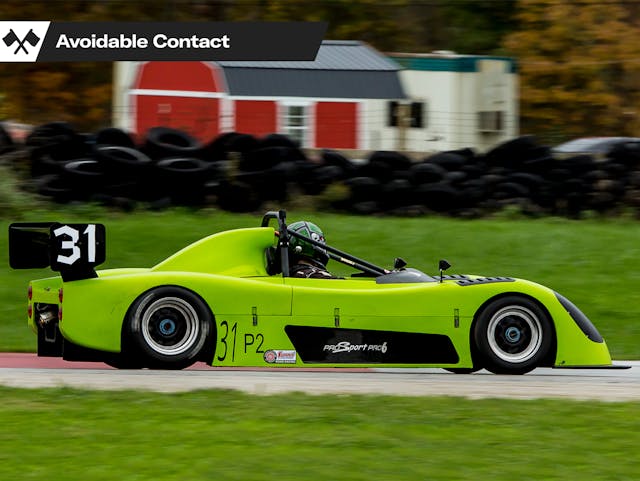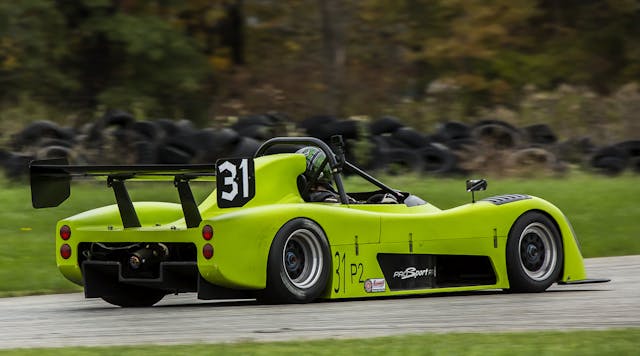Avoidable Contact #125: In which perhaps too much respect is shown, a wheel explodes, and the author is “stuck”

“You put me off three times, you know.” The fellow delivering this news to me didn’t seem angry. Maybe a touch disappointed. And who could blame him? He’d paid to race heads-up in the Formula Enterprise 2 class against a multiple National Champion, but some moron in a carbureted Radical kept knocking him into the weeds, forcing him to finish second in a field of … two! Meanwhile, the aforementioned Radical moron, namely moi, was frantically replaying the race in his head. How had I hit this fellow three times and not noticed? More importantly, how did he survive three hits in an open-wheel formula car? And should I just mail my competition license back to the SCCA, or should I cut it in half first?
Ah, but there was more to it than that—and while I believe the incidents in question were still my fault, it’s not as clear-cut as it seemed. Turns out I’d never actually touched him. While the definition of “putting off” in most production-car-based classes involves some sort of contact, usually avoidable; the open-wheel crowd is a little different. Recall with me, dear reader, the October competition debut of my Radical, in which a board of SCCA members specifically told me to yield to faster cars. As in … get out of their way. Insofar as I am always the agreeable sort, I resolved to follow those directions.
Three weeks later, during Saturday’s race at Nelson Ledges, every time I was shown a blue flag I moved off the racing line so the formula cars could go by without impediment. I did it with the sort of hyper-self-conscious timidity of a misbehaving teenager trying to sneak back into the house after midnight, hoping all the time that I wasn’t impeding my betters by too much in the course of doing so.
This worked pretty well with most of the cars in that race, but this one fellow kept expecting me to stay on line, so every time I moved over for him he found himself committed at high speed to a line that ended in my taillights, at which point he swerved off track in order to correct the situation. Three laps in a row, apparently. In his shoes I probably wouldn’t have tried Midcorner Passes Two and Three, particularly given that he had all the motor he needed to zip by me on either of Ledges’ considerable straights. Isn’t the definition of insanity doing the same thing again and again while expecting a different result? Still, I didn’t feel good about what I’d done to him, so I talked to the chief steward.
“Uh, in the other region they told me to get out of the way of the fastest formula cars, which struck me as weird, but I’m here to cooperate,” I explained. He looked at me like I’d told him my name was Simon and the things I drew came true.
“That,” he replied, “is the stupidest thing I have ever heard. Who told you that?” I gave him the name. “Yup. What I expected. From them. Over there. So in their region, you do what they say. In this region, you stay on a predictable racing line and make them pass you off-line.”

“Copy that.” Come Sunday’s race, I did precisely what he asked, and no feathers were ruffled. Even better, removing any trace of deference from my laps allowed me to get down from a 1:12.1 to a 1:09.9. This is a few seconds off the P2 lap record for Nelson Ledges, and maybe seven seconds off what a good Stohr WF1 sports racer could do with fresh tires and a first-rate driver. Not great, but no complaints on my part. As Roy “Future Man” Wooten once said in a Flecktones song, man cannot jump to the absolute. He must go forward from where he stands. Not only am I driving a relatively modest car with extremely modest power, I’m also learning as I go. There’s so much we don’t yet know about my little Radical.
Examples: Experienced operators of the Radical PR6 know that the front wheels are subject to all sorts of failures. Unlike the original Radical Prosport, which had a little bit of free space inside its 13-inch-diameter wheel barrels, the PR6 uses oversized front calipers that, in certain conditions, can actually score a line into the inner rim. And the heat of the PR6’s brakes can also cause heat-related failure in the Nylok fasteners that hold the three-piece wheels together.
I didn’t know any of that, which is why I was, shall we say, highly surprised when my right front wheel came apart during the white flag lap of Sunday’s final race, yanking the wheel out of my hands in the middle of what my AIM Solo said was a 1.81g turn. After darting off the racing surface in not entirely voluntary fashion like a freshly caught tuna trying to escape the Star-Kist boat, I got the car under control and drove around on a flat tire to finish the race. Happily I’d lapped enough traffic earlier in the day that I didn’t even finish dead last! One of the formula cars drove by me as I was doing 30 mph down the back straight, however, and I could just about read his mind: That’s the moron who was moving over on blue flags yesterday, and now he’s doing golf-cart pace where I’m doing 145!
Over the winter, I’ll be disassembling all my wheels, replacing the 15-year-old forged rim halves with new pieces from the original manufacturer, and reassembling them with “tri-lock” nuts rather than Nylok nuts. Several of the front wheels in my inventory had the radial scoring that is the warning sign of a PR6 wheel collapse. I just didn’t know what it meant, or that it was a problem.
There’s a lot to criticize about Zen and the Art of Motorcycle Maintenance, much of it related to the idea of making your mentally ill son ride on the back of a 305cc Honda for weeks at a time, but I always appreciated what Robert Pirsig wrote about being “stuck” in a situation. The moment of “stuckness” begins when you realize you have no good ideas for moving forward, no “best practices” to follow. Maybe it’s because you’ve snapped the head off a bolt while disassembling an engine case, which is the example Pirsig uses in the book. Or maybe you have a problem—technical, mechanical, or personal—that seems to have no obvious solution. The time that you pass between realizing your dilemma and solving it is the time of “stuckness,” where your mind is working on the problem in ways you can’t completely predict or understand. Pirsig writes:
Stuckness shouldn’t be avoided. It’s the psychic predecessor of all real understanding. An egoless acceptance of stuckness is a key to an understanding of all Quality, in mechanical work as in other endeavors. It’s this understanding of Quality as revealed by stuckness which so often makes self-taught mechanics so superior to institute-trained men who have learned how to handle everything except a new situation.
After 15 years of racing production-based cars everywhere from Sebring to Sepang, I’d come to believe that I didn’t have much more to learn about this hobby. I’m not saying I’m the greatest driver out there; far from it. But I’d experienced enough that I usually knew what was happening to me, even if the “what” amounted to “You’ve outbraked yourself, moron, and now you’re going to sit in the gravel trap for the next 20 minutes.” I can’t remember the last time I was genuinely surprised or confused during a race or track day.
My first two weekends running a Radical in the proverbial fastest run group, on the other hand, have provided me with multiple opportunities to feel “stuck.” There’s so much I need to learn about prepping and adjusting the car, and I’m not sure what I need to learn first. Everything about the way the little PR6 handles a corner, from the way the nose hunts around on entry to the thin line between “warp speed” and “whoa spin” on the exit, is written in a language that has very little to do with the lingua franca of predictable production sedans. Spring rates? Shock tuning? Alignment? We don’t know what’s right, and we don’t know how to find out in a hurry. Fewer than a hundred of these sports racers were built, and only a handful are still turning laps. I’m certain we are learning lessons, and making mistakes, that would be old hat to dozens of Radical veterans out there.
This sounds like a litany of complaints when in fact it’s a recitation of joys. To be 50 years old (as of this week!) and to be passionately involved in something as a relative novice? That’s a true gift, one given to very few men in my stage of life. To be truthful, it’s addictive. No doubt my crew and I will figure this Radical out, soup to nuts, in the year to come. And then what will we do? Get a faster one? Make bold changes to this car in search of truly frightening speed? Sell the whole rig and buy an LMP3? (You should see what they’re doing with home-equity loans noawadays.)
I have no idea what will happen between my last lap on Sunday and the last lap of my life as a racing driver, whenever that occurs. But I’ll tell you one thing: I’m excited about all of it, and not, ahem, “put off” at all.


